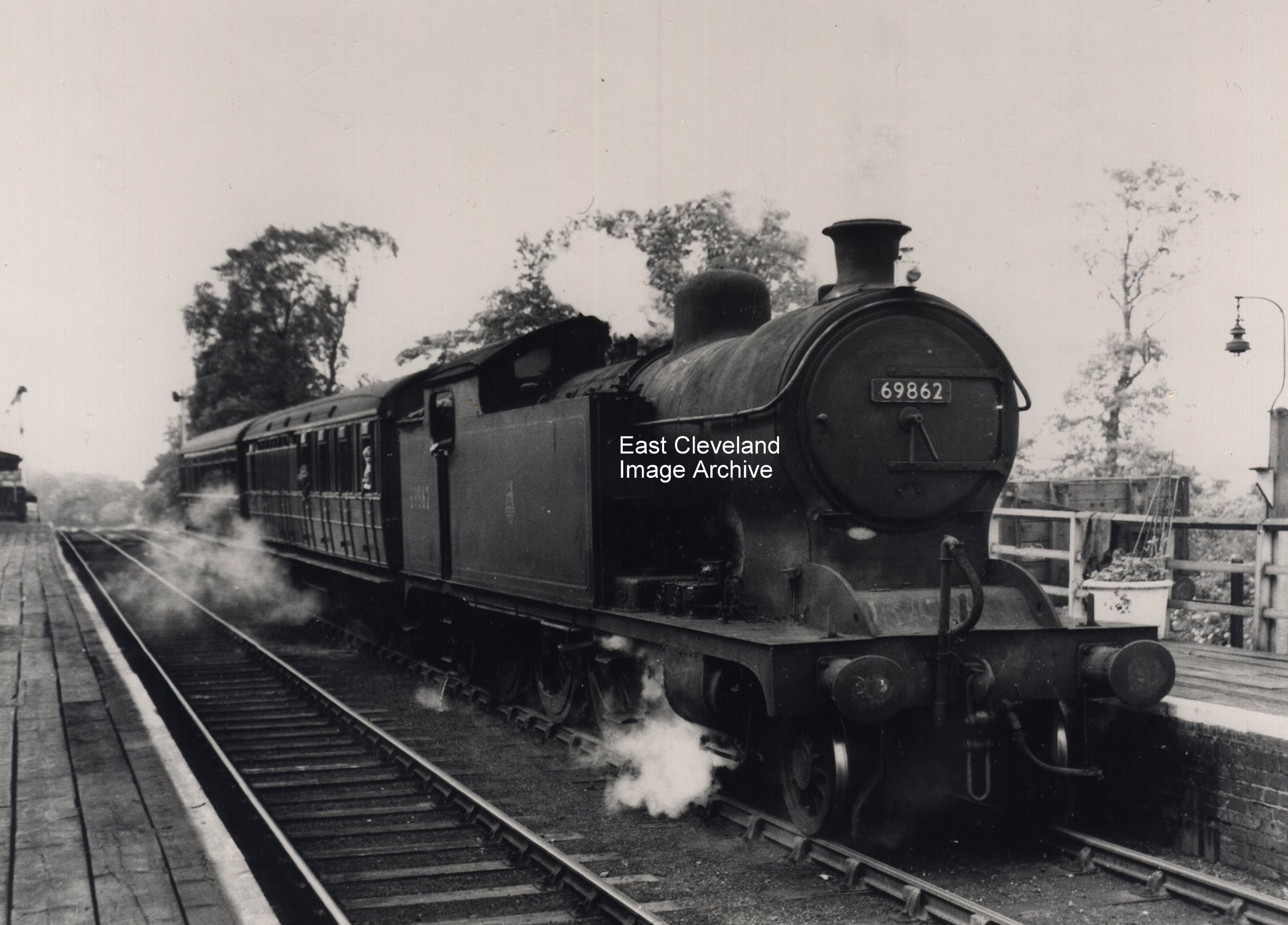
We wonder whether that first coach of this train made it to preservation? The locomotive a Raven/Gresley A8 4-6-2T 69862 didn’t, it was cut up at Darlington in 1958.
|
|
||
|
We wonder whether that first coach of this train made it to preservation? The locomotive a Raven/Gresley A8 4-6-2T 69862 didn’t, it was cut up at Darlington in 1958.
Taken from the old road bridge that carried the A171 over the railway at Slapewath (the scene of many minor bumps in the distant past), the picture shows the backs of the houses at Slapewath. The train is approaching Spawood junction from Boosbeck. It’s difficult to visualise this view now as the A171 re-alignment was so major, I seem to remember two bridges, one over the railway, one over the beck and one rail bridge over the road (to South Skelton or Park) pit) at Fancy Bank (the remains of the railway can be seen on the hillside as a gated forest road). Some of the remains of the old road and rail structures can be seen with the beautiful viaduct at Spawood (now becoming enshrouded in trees) and the road bridge over the beck adjacent partly covered by the modern A171 as it sweeps down Fancy Bank. I think the locomotive is numbered 67678, which would make it a V3 2-6-2T, but it’s not an easy one to see.
There’s not a lot to say about this image – it’s a photograph of Commondale Halt – as a location we were initially uncertain. Updated location courtesy of Simon Chapman.
An image of the unique cableless locomotives used by The Grinkle Mine of Sir Charles Mark Palmer to negotiate the low headroom in the tunnels on the route from Grinkle to Port Mulgrave. In the background is the Dale House end of the Port Mulgrave Tunnel; at the other end the wagons were transferred to the dock at Port Mulgrave using a main and tail rope system powered from an engine-house on the Port Mulgrave side. A real bit of industrial history!
A shot of the Whitby-Middlesbrough platform at Grosmont Station, change here for Pickering and all intermediate stations. Alan Woods tell us: “The locomotive number is 69877.” The junction point of two railways, the Whitby-Pickering and the Whitby-Middlesbrough lines. Both lines still traversable by train, the Middlesbrough-Whitby Line having escaped the Beeching axe by virtue of remoteness (it wasn’t economically viable to replace the routes with a bus service) and the Grosmont-Pickering Line by the good fortune of becoming the first Heritage railway; The North Yorkshire Moors Railway. A line I’ve been travelling regularly since they had ”Salmon”. Long may it flourish! Thanks to Alan Woods for the update.
A good shot of BR Standard 2-6-4T 80118 standing at Guisborough Station with a local train. Alan Featonby tells us: ”80118 was allocated to Whitby (50G) shed at this time and is on Middlesbrough to Whitby service via Loftus, depending on the time of day it could have run to Scarborough. The train, having run directly into Guisborough station from Middlesbrough, would reverse back to Hutton junction prior to changing direction once again to head towards Brotton. These 4MT tank loco’s were turned at Middlesbrough in order to run chimney first up Nunthorpe bank thus ensuring water was always around the firebox. There was no Saltburn service between 1955 and 1958 when this photograph was taken. I suspect this train is the first return working on the last day of through running to Whitby in 1958 and it did terminate at Whitby. 80116 and an L1 doing the final honours on the Scarborough trains. DMU’s then took over the service on the following Monday but from Loftus to Middlesbroug; the Esk Valley route then being the only route to Whitby from Middlesbrough.” Many thanks to Alan Featonby for this explanation of this lines working systems at the time this image was taken.
Here we have another type of drill being tested and another photographic record of the event. The backlash of this automation was that fewer men were required to produce the same (or better) yield and a lot of miners were downgraded (with loss of pay and status) to loaders/drivers or simply made unemployed. Once again does anyone know the type of drill and the name of the miner?
Anomalously called Skinningrove, but originally called Carlin How, nothing remains of this station now except a locked gate and some footings. The photographer is standing on the Loftus side looking towards Skinningrove Iron and Steel Works; perhaps that is the real reason for the re-naming of the station!
Brotton Station – old faithful 80118, a BR Standard 2-6-4T – waits with a Loftus-bound local train. Lovely atmospheric shot this one, plenty of life in it. The view is looking south so the train is heading towards Huntcliff and Loftus, not Saltburn. Information courtesy of Simon Chapman.
Not so old here – we’ve got colour light signals. A goods train, headed by 0-6-0 class J39 64848, chugs ponderously past; east of Thornaby Station, heading west on the goods line. We are told by Dale: ”The locomotive is J39 64848, of West Auckland (51F); it has a white smokebox door boss. This had been painted to indicate all 51F sheded locomotives by the shed boiler inspector.” We are now advised by Geoff Swales: ”The white smokebox door boss was painted by West Auckland boilersmith, (not inspector) – Gordon Reed – boilersmith from mid 1950’s until shed closure.” Thanks Simon Chapman, Alan Woods, Dale and Geoff Swales for the updates. |
||
Recent Comments